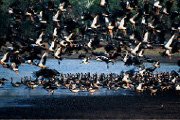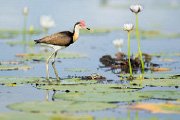Darwin woollybutt
The Darwin woollybutt is common across the Top End, including the lowland and savanna woodlands that border most roads in Kakadu.
This hardy eucalypt has rough, fibrous bark on its lower trunk and smooth white bark on the upper trunk and branches. The woolly bark around the base protects the tree during patch burning in the early dry season.
The woollybutt provides food for many of Kakadu’s birds and insects – native bees, lorikeets, honeyeaters and friarbirds can often be seen suckling from the nectar-laden flowers.
Culture
Bininj/Mungguy use the Darwin woollybutt as a seasonal indicator. In Yekke (May–June) the tree produces spectacular orange flowers. These tell people that it’s time to start lighting fires to clean up the Country and prevent wildfires later in the dry season.
The timber from these sturdy trees is used for firewood, building materials and making didgeridoos. Bininj/Mungguy also eat the seeds and brew an infusion from the inner bark to treat diarrhoea.
Scientific name
Eucalyptus miniata
Take the first step
A journey of 1000 miles begins with a single click.
Enter your email to get free trip planning advice from Kakadu rangers.





